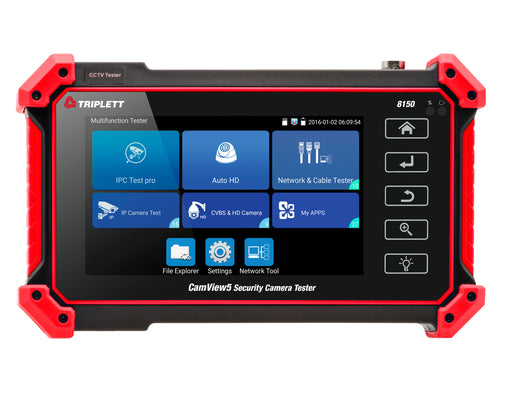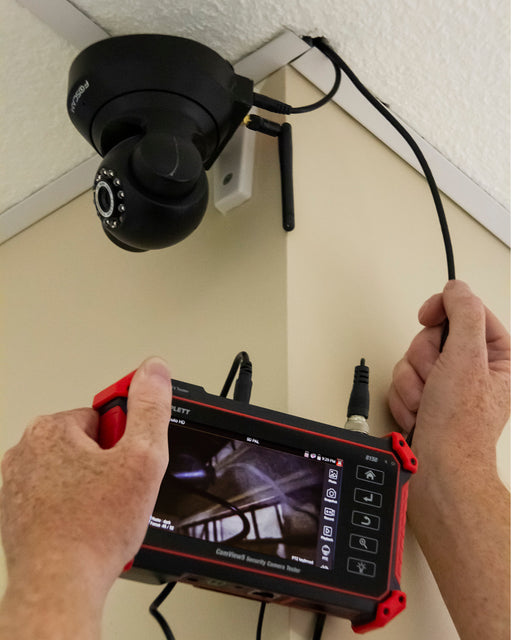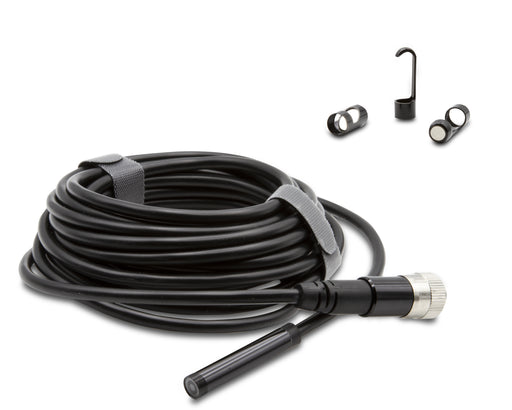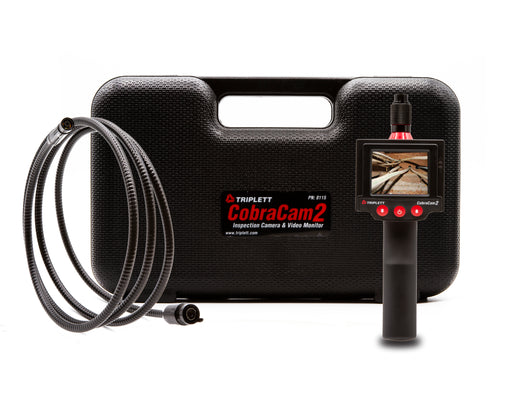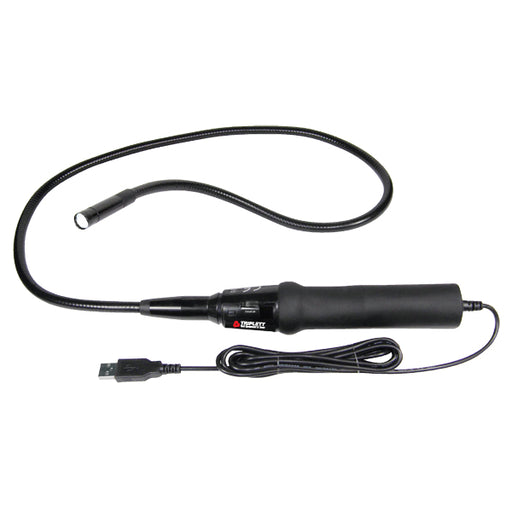Know More About Triplett Borescopes & Inspection Cameras
What is a borescope?
It is an optical tool that comprises a flexible or rigid tube with a digital display on one end and the objective camera or lens linked by an electrical system between these ends. It is also referred to as a videoscope in some scenarios.
What is an inspection camera?
It is a popular digital tool used by inspectors to collect visual data in cramped-up or inaccessible areas. The inspection cameras are small and can easily slide into hard-to-reach areas. They are used by professionals to see, inspect, and investigate issues in the areas that are not generally visible to naked eyes such as the ceiling cavities, the areas behind walls, down the pipelines, on small parts within automobiles, and so on.
The cameras usually comprise a flexible probe or long arm to which a miniature camera module is attached. An inspection camera may have a color or black and white display. They are available in fixed as well as detachable configurations. The video inspection camera kits may feature a small screen that offers the relay of the live video. Many digital inspection cameras are connected through Wi-Fi and work remotely and wirelessly, and their images are usually displayed on a remote screen such as on a phone or a computer.
What is the difference between a videoscope and a borescope?
Videoscope and borescope inspection cameras are similar in many ways. The following pointers will help you understand it better.
- Borescopes: This type of digital inspection camera has fewer and simpler features. They generally transmit images through a rigid or fixed insertion tube. This tube is connected to a digital screen.
- Videoscopes: It is a type of borescope that may possess several leading-edge features including image or video recording. They include several features such as articulated controls on the control handle, an insertion probe section, a lighting bundle, a cable interface with display outputs, an external light source of high intensity, and so on.
What is the purpose of borescope inspection?
Borescope inspection cameras are used to inspect industrial equipment and systems for checking damages and quality. Borescope inspection cameras are used to inspect the following:
- Manufactured parts
- Foreign objects
- Welds
- Heat exchanger tubes
- Pipes
- Internal combustion engines
- Turbine engines
How far can a borescope see?
The video borescope inspection camera is equipped with a bright light and offers a broader view. This view field may range between 50 and 120 degrees or larger. The view field can be easily adjusted using the viewing unit or handset.
How to use an inspection camera?
Video inspection cameras feature quite simple designs and are easy to use. Although these cameras have gained immense popularity in recent years, many people are reluctant to use them thinking they may need special skills. These cameras are easy to use; however, you need to take care of a few things.
- Decide on the specifications of the insertion probe such as flexible or rigid insertion probe, diameter and length of the insertion probe, and so on.
- Take care to choose the probe in the right diameter and length for the desired results. These probes are fragile and may break down if bent beyond their capacity.
- Place the probe of the camera near the inlet and insert it carefully.
- Put on the light source and adjust the intensity according to your visual needs. You should be immediately able to see the desired area.
- Next, put on the recording button and start recording your video in the desired format.
- It is always recommended to use a borescope camera attached to a fairly long probe and tip articulation for better results.
What is a pipe inspection camera and how does it work?
Pipe inspection cameras are used for inspecting the pipe condition in water pipe networks, drain pipe, ducts, and so on. These cameras are generally used during pipe maintenance and repair to analyze blockages, irregular pipe conditions, etc.
These cameras are connected to display devices. The powerful lights on these cameras illuminate the pipe’s interiors and you can see the clogging, debris, damages, and other issues in real-time. Our pipe inspection cameras or boroscopes enable maintenance and repair teams to identify the source or area of problem and perform remedial measures with minimal disruption.
What are the types of borescope?
We provide flexible borescopes known for their versatility and are ideal for examining ducts, vents, and curvy pipes. These borescopes feature tubes that use optical fiber to transmit an image of the camera’s eyepiece. The fiber optics make the tubes versatile, flexible, and economical. Our flexible borescopes can cover long distances and deep areas with greater accuracy and detail. This camera can be tilted and possess a high degree of movement.
Our flexible borescopes have gained popularity over the years. However, you find rigid and semi-rigid borescopes in the market.
- Rigid Borescopes: These devices offer the highest resolution, but are more suited for straight paths. They do not flex like flexible borescopes and relay the image through lenses. These borescopes can have several viewing directions based on prisms and mirrors. They use an eyepiece, which can be easily connected to the camera.
- Semi-rigid Borescopes: These borescopes use fiber bundles for image relay. The fiber bundles are fused, limiting their flexibility to a certain extent. Semi-rigid borescopes are smaller than rigid and flexible borescopes and some products may measure as small as 0.4mm, making them more appropriate for inspecting small parts. These borescopes are usually fragile.
Are Borescope Cameras Waterproofed?
Yes, most borescope cameras are offered in a waterproof enclosure. Our waterproof cameras are IP67 certified and are perfect for use in wet areas. They come with anti-freeze protection.
How to Choose Video Borescope?
Video borescopes are versatile tools that are used in various industrial and commercial settings. When choosing video borescopes for your application, there are several things to consider.
- Video borescopes may feature flexible, semi-rigid, and rigid tubes. You can choose the one based on your inspection requirements.
- Nowadays, digital inspection cameras are gaining popularity. You can view the captured images or videos on display in real-time. You can find three types of screen displays – LCD screen, USB, and wireless. We provide USB boroscopes to transfer the images to your PC using a removable SD card or the USB interface. Many wireless borescopes allow you to download the app to visualize the information. You may need a Wi-Fi signal to visualize the data in real-time. If you consider the one, ensure these borescopes are compatible with your iOS or Android devices or computers. If you use a borescope equipped with LCD screens, you may not require additional display devices.
- They differ in brand, length, scope, features, quality of images, resolution, etc. Comparing prices of different models is one of the best ways to find the right product. While doing so, ensure the type of digital borescope chosen fulfills your inspection requirements and offers you the best value for investment.
- If you plan to use the borescope and inspection cameras for sewer or pipeline inspection, ensure to check the ingress protection. The camera probe must be waterproof and water-resistant.
- If you plan to use the borescope to gain an overall view of a pipeline or duct, ensure you choose the borescope with a dual camera. It features both front-facing and side cameras. These cameras offer you an option to view from all sides at a 90 degrees angle.
Why Borescope is the Best Form of Non-destructive Testing?
Borescope inspections are considered one of the best forms of non-destructive testing because they enable you to visualize the affected areas without breaking, digging, or disassembling the surrounding regions. The systems use a rod lens system, relay lens system, CMOS, and a fiber optic image guide to perform this task.
When to Consider Pipe and Sewer Inspection Camera?
Sewer inspection cameras are used to determine the health of sewage systems in your homes and commercial facilities. However, it is always better to detect the pipe issues earlier, as they would lead to expensive repairs. The following are two scenarios where pipe inspection cameras or sewer inspection cameras can be useful.
- Sewer backup issues warrant expensive repairs, and you may notice:
- Foul smell near drains
- Overflowing drains
- Bubbles found in toilets for a prolonged time after flushing
- If you live in old property, the pipe inspection camera can be a good investment. Our flexible cameras can easily percolate through constrained areas. You can get an overview of pipes in drains and ducts and conduct repairs before damages become too severe.
Browse More Building, Maintenance & Environmental Collections
Inspection & Laser Distance Meters:
| Photo & Contact Tachometers | Manometers | Laser Distance Meters |
Gas Meters:
| CO & CO2 Meters | Combustible Gas Detectors | Formaldahyde Meters |
Environmental Meters:
| Sound & Noise Level Meters | Humidity Indicators & Meters | Non-Contact & Contact Thermometers |
| Particle Counters | Moisture Meters | Light Lux Meters |
| Vane Anemometers | Hygro-Thermometers | Digital Hygrometer |
Water Quality:
| PH and Conductivity Meters |




